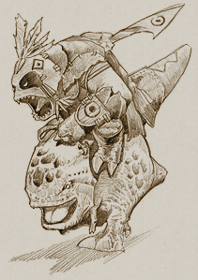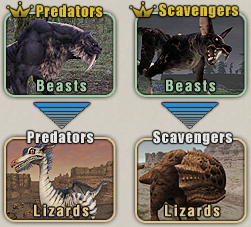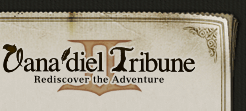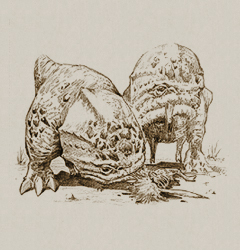Greetings, everyone! Atelloune, the "Wildlife Lady," has returned!
We've received a lot of letters from you all again. Today, let's take a look at this question from a little Tarutaru boy:
Dear Wildlife Lady,
I'm a Beastmaster that loves lizards, but I hate that I have to use that awful carrion broth to call them. Why do lizards like that disgusting stuff?
Okay then, as per the Taru boy's request, today's topic will be lizards.
Lizards are the most recognizable members of the carnivorous lizard family. There are other types of carnivorous lizards, like raptors, efts, and according to my professor, Goo--whoops, maybe I'll leave that to another time.
Now, let's look at the different species of lizards.
The ones you see the most seem to be hill lizards. They can be found in various regions such as Gustaberg, Southern Zulkheim, Vollbow, and Aragoneu. They generally tend to live in dry areas--the ones that aren't kept as livestock by the Orcs, that is... Oh, you didn't know about that? It's a pretty well-known fact that Orcs raise hill lizards. Take a look at this quote from one of Professor Chanoix's writings:
"Did you know that Orcs raise lizards for food? That's right! They also use them as 'watch lizards' to guard their houses, 'riding lizards' to ride like chocobos, and 'war lizards' to fight for them. Isn't that neat?"
...I forgot to mention that the source of the quote is "Fun Wildlife Facts for Kids," one of the professor's lighter works.

Now that we are revisiting our childhood years, let's take a look at the picture to the right. This is a picture of an Orc knight and a riding lizard that Professor Chanoix claims to have seen in Ghelsba three years ago. Hmm, is it me, or does it look like neither are showing much brain activity? Okay, moving on...
The next most common type of lizard is the ash lizard, found only on the remote island of Elshimo.
"Ash lizards can inhale a little poisonous gas without getting sick, so they can live near volcanic mountains. Wow!"
Yes, wow indeed. This brings up the interesting point, though, of why ash lizards came to live in such a harsh terrain in the first place.
The answer is that they had no choice. Not just ash lizards, but all lizards we see throughout the world were chased out of areas where food is abundant--the poor things. Let's take a look at one of the professor's papers to see why...and now we're back to the adult stuff!
"Carnivores can be largely divided into two types: predators, which hunt their prey, and scavengers that feed on discarded flesh (carrion). The lizard family branched out in both directions. Those that became predators developed quick and powerful legs in order to hunt in packs, and those that became scavengers gained a heightened sense of hearing and smell to detect the cries of prey and the scent of rotting flesh. Many such scavengers also grew in size in order to compete for game with predators."
Okay, attention please! The best example of a predator in the lizard family right now would be the raptors.
And of course, for scavengers we have... lizards!
"By dividing into predators and scavengers, the lizard family gained an efficient system of food distribution that allowed them to prosper for a long time. However, the advent of the beast predators destroyed that balance and threatened their very existence. The beast predators were smarter than their lizard counterparts, and eventually the beasts would replace the lizards as the top predators."
Now close your eyes and think back. In what kind of area do you usually see a raptor? That's right, they usually dwell in barren wastelands. According to Professor Chanoix, the natural quickness of raptors is ideal for hunting in such terrain, and that's why they were able to keep their status as top predators.
So what do you think happened to the scavenger lizards?
"The rise of the beasts dealt an even greater blow to the scavenger lizards. Because of their great size and their lumbering speed, they became easy prey for the agile beast predators."
How ironic--carnivores being hunted by other carnivores. In the end, most scavenger lizards are said to have died out. Only the smallest varieties were able to escape into less fertile areas and escape extinction. Of course, those lucky guys are what we now commonly refer to as lizards.

Okay then, as a reward for paying attention thus far, I have a special treat for you. Behold, the "Changing of the Guard" diagram! Very cool, don't you think? Enjoy!
Okay, now let's talk bugards, and then wrap things up.
"Tavnazia , a land known for its unique ecosystem, is the habitat of the bugard, a particularly large member of the lizard family. Since their bone structure is extremely similar to that of common lizards, it can be theorized that these creatures are direct descendants of the giant scavenger lizards of old."
Tavnazia has been isolated from the rest of the world by mountains and seas for a very long time, so it wouldn't be surprising at all if the giant scavenger lizards that dwelled there were never discovered by the beasts, and are thus still thriving today. What do you think? I hope you were paying attention, because this is going to be your homework assignment!
Anyhow, the answer to this week's question is...
Because lizards are scavengers that feed on the flesh of dead creatures, they can't help but pounce on that tasty carrion broth doled out by beastmasters.
Satisfied?






